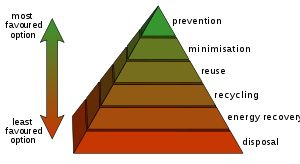There are some truly biodegradable and compostable bioplastics.
Biodegradable products break down through a naturally occurring microorganism into simple, stable compounds which can be absorbed into the ecosystem. More about biodegrading here.
To be classed compostable, items must biodegrade within a certain time (around the rate at which paper biodegrades), and the resulting biomass must be free of toxins, able to sustain plant life and be used as an organic fertilizer or soil additive.
Compostable Plastics – PLA
Polylactic acid, (PLA), plastic is an example of a biodegradable bioplastic. PLA or polylactide was discovered in 1932 by Carothers (at DuPont). (Whats a bioplastic? Find out here)
 PLA is a bio-polymer
PLA is a bio-polymer
Bio-polymers can be produced from natural resources
A natural bio-polymers is one that is extracted directly from biological raw materials such as cellulose and cotton from plants, wool from sheep and silk from moths
Man made bio-polymers are also derived from plants but then further treated using chemicals.
Poly-lactic acid (PLA), falls into this category.
PLA is made from the starch found in plants including beets, sugar cane, and tapioca.. Starch is a natural polymer, a white, granular carbohydrate produced by plants during photosynthesis Starch can be made into bio-plastic. However when exposed to water starch bio-plastic swells and deforms.To stop this happening the starch needs to be modified

Starch is transformed into PLA by;
1) Using microorganisms to transform it into a lactic acid – a monomer
2) Then chemically treating the lactic acid to create a long chain polymer, polylactic acid – PLA
There are several different types of Polylactic Acid
Racemic PLLA (Poly-L-lactic Acid),
Regular PLLA (Poly-L-lactic Acid),
PDLA (Poly-D-lactic Acid),
and PDLLA (Poly-DL-lactic Acid).
Recycling
PLA can be recycled back into lactic acid and used to make products of the same quality as the original- there is no down-cycling. Currently only recycled in Wisconsin and Belgium.
Biodegradable
PLA products biodegrade into water, carbon dioxide and organic materials. and so can be composted.
“First, the moisture and heat in the compost pile split the polymer chains apart, creating smaller polymers, and finally, lactic acid. Micro-organisms in compost and soil consume the smaller polymer fragments and lactic acid as nutrients. Since lactic acid is widely found in nature, a large number of organisms metabolize lactic acid. The end result of composting is carbon dioxide, water and humus, a soil nutrient. This degradation process is temperature and humidity dependent. “
In commercial composters this should take about 30-45 days. In home composting bins it might take longer. Obviously the bulkier the product the harder it is to break down, and the longer it takes.
Rotting Away
a PLA bottle left in the ocean will biodegrade in six to 24 months.
It can be used for medical implants that biodegrade over time
NB PLA will not compost in landfill.
Composting PLA Plastic At Home
While most agree that PLA plastic is indeed compostable, many say that it can only composted in large scale municipal schemes. As we don’t have many large scale municipal schemes this they say is a pointless advantage.I say the days of large scale municipal schemes is fast approaching as governments aim to divert biodegradable rubbish from landfill sites.
Moreover I have been composting my PLA plastic for years. We have used and composted the following PLA plastic products ( including Biobags , Deli pots and disposable Cutlery )

The Rest
Are PLA products safe to eat?
People …PLA products are not edible yet are generally non-toxic. Small pieces of PLA will most likely pass harmlessly through the gastrointestinal tract. Once passed through the gastrointestinal tract it will be eliminated in the stool.
Pigs …PLA can apparently be returned to the food chain. I have heard it suggested that you can feed it to your pig. Please double check.
I am allergic to corn; could I still use PLA products?
Yes, the heat used in the process of deriving the starch from corn destroys the immunologically reactive profiilin. Profilin is the chemical that usually causes an allergic reaction and is not found in PLA products.
Burning PLA Plastic
PLA will not emit toxic fumes when incinerated.
Useful stuff to know
Remember, not all bio- plastics can be composted and some are not as green as they sound
Find out about composting here.
PLA products I use











 This means that plastics have to be identified and sorted into types. In the olden days recyclers had to rely on the plastic code stamped onto the plastic product and sort by that. These days most use automatic sort systems to identify the resin, such as near infrared (NIR) technology. “
This means that plastics have to be identified and sorted into types. In the olden days recyclers had to rely on the plastic code stamped onto the plastic product and sort by that. These days most use automatic sort systems to identify the resin, such as near infrared (NIR) technology. “







 PLA is a bio-polymer
PLA is a bio-polymer
